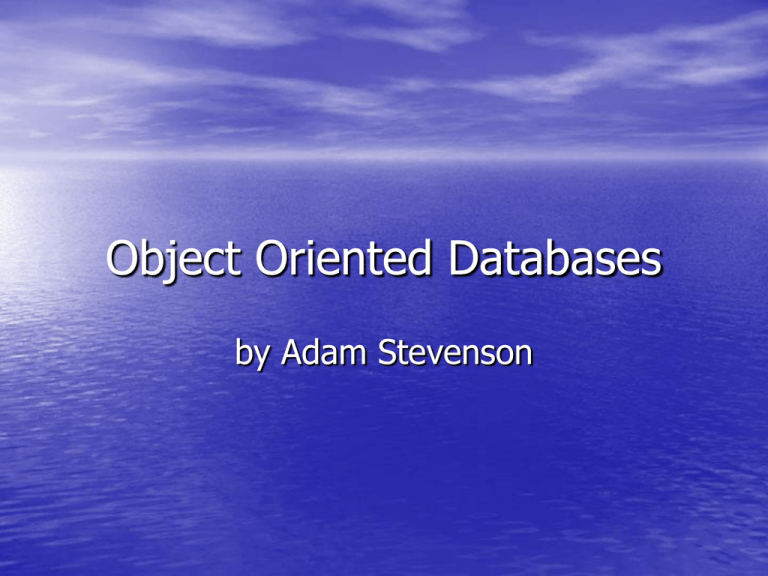PPT - ODBMS.org
advertisement

Object Oriented Databases
by Adam Stevenson
Object Databases
• Became commercially popular in mid 1990’s
• You can store the data in the same format as
•
•
you use it. No paradigm shift.
Did not reach full potential till the classes they
store were decoupled from the database
schema.
Open source implementation available – low cost
solution now exists.
Object Database Vendors
• Matisse Software Inc.,
• Objectivity Inc.,
• Poet's FastObjects,
• Computer Associates,
• eXcelon Corporation
• Db4o
Db4o
• Object Database
• Can be used with .NET or Java platform.
• Supports Acid Transactions
• Small foot print
• Does not require schema files since it runs
natively.
SQL Server
When designing for Sql Server must you consider
when using SQL Server?
• Process Model
• Sql Server Installation
• Table Creation
• Stored Procedures
• Possible Separate User System
• Platform Specific
• Views
• Intermediate Table Creation
• Possible Security Issues
• Mapping Code
• Server Centric
Installation – Sql Server
• Sql Server must install Sql Server on server.
• Client can save information to datasets offline.
• For an application shared across a client and a
server, separate code must be written for select,
insert, update and delete operations – one set
for sql server, one for the dataset operations.
Process Model – Sql Server
• Requires the installation of two services,
each running out of process.
• Requires inter process calls to save
information to the database.
Process Model – Db4o
• Requires the use of a dynamic link library
(dll). Represented in memory as a static
object.
• Runs in the same process as the running
application, so call overhead the same as
calling any other function.
Installation – Db4o
• Just have the dynamic link library included
as part of your application.
• Application requires
– An in memory stream, or..
– An isolated storage stream, or..
– A file stream, or..
– A network stream.
• Stream Flexibility and Nestability
Table Creation – SQL Server
• For each object in your client model,
usually at least one table needs to be
created.
– Object Tables
– Linking Tables
“Table Creation” - Db4o
• You do not need to create any special
objects to store your data in Db4o.
• The same objects you use in your code
class structure can be saved to the
database.
• Since it saves the graph, no linking entries
need to be made.
Sql Server – Stored Procedures
• For each insert, update, delete, and select
statement - a stored procedure.
– Separate Language
• Another language for your team to learn.
– More code to manage
• Small changes add up
– Have to write insert, update, delete select
procedures for each type you want to
serialize.
“Stored Procedures” – Db4o
• You don’t have to write any update,
delete, insert, or select procedures if you
do not want too.
• More complex select procedures might
require a separate function.
• Written in the same language
User System – Sql Server
• Either need to use Windows Security, which
•
•
•
causes your application to be tied down to a
implementation, or use Sql Server Security.
Both options require a separate security cost
CALs.
Both require the application to support an
outside system.
ACID transactions require use of separate user.
User System – Db4o
• Use whatever security you want to use
with the application.
• Can use code access permissions
• Does not require to extend your program
Platform - MS Sql Server
• Requires an Microsoft Operating System
Platform – Db4o
• Can run on almost any platform. Just
needs to support Java or MS.NET or Mono.
Views – MS SQL Server
• To increase performance, MS Sql Server
offers views. These views though can be
costly in terms of memory.
Views – Db4o
• Does not have them. Your data is already
in a graph structure.
Intermediate Tables
• Relational Databases require intermediate
tables to be created to maintain n to n
relationships.
• Object databases do not require this step.
Security - SQL Injection Attacks
• To avoid SQL injection attacks, we must
be careful about how we write our code.
• Must either use Stored Procedures or input
filters to ensure that an attack does not
succeed.
• Either way, more complexity to manage.
Relational Mapping Code
• “Thirty percent of an application's code alone is
•
•
used for mapping an application's objectoriented design to the database's relational
model [1].”
Mapping code is not a problem till you need to
change your code to incorporate new features.
What could you and your team do with 30%
more time for coding?
1 - http://www.15seconds.com/Issue/030407.htm
Server Centric – SQL Server
• Requires that the database be located on
a serving device.
• Clients must use a dataset, a separate
object for writing information and then
synchronize the information.
• Does not support dual client - server
mode.
Server and Client Centric – Db4o
• Db4o can run the same code as if it was
on a server or on a client computer.
• Can be easily synchronized
• Can run be deployed as a connected or
disconnected client model.
Db4o Basics
•
•
•
•
•
•
Database Creation
Defining your data classes
Inserting
Updating
Deleting
Queries
– By Example
– Advanced Queries
Basics: An Eight Line Example
“Coders never had it so simple.”
ObjectContainer oContainer = new ObjectContainer(@“C:\MyFirstObjectDB.odb”);
Person oPerson = new Person(“Adam”);
oContainer.set(oPerson); // Insertion
oPerson.Name = “Eve”;
oContainer.set(oPerson); // Update
ObjectSet oSet = oContainer.get(oPerson); // Query By Example, a.k.a. Selection
oContainer.delete(oPerson); // Deletion
oContainer.Close();
Basics: Database Creation & Your
Options
• Create In Memory Database
• Create a Database from a File Stream
• Create a Database using an Adapter
– Supports Network Streams
– Custom Encryption
– Isolated Storage
Basics: Insertion
• To insert a new object into the database,
it just takes one step:
oContainer.set(oPerson);
• You can configure your the database to
only save certain members and how deep
to save.
Basics: Updating
• To update an object in the database, it
just takes one step:
oContainer.set(oPerson);
• Notice the same command is used. This
can be done because it keeps track of the
reference to the object.
Basics: Querying By Example
• Examines field values. Any field not set to the
•
default value for that data type is used in the
query.
Provides easy fast queries.
oPerson.Name = “Adam”
oPerson.Address = “132 Main Street”
ObjectSet oSet = oContainer.get(oPerson);
while (oSet.hasNext())
{
Person oSelectedPerson = (Person)oSet.Next();
}
Basics: Deletion
• To delete an object in memory that db4o
knows the reference too:
oContainer.delete(oPerson);
• Otherwise do a query and then call the
delete.
// Do Query to get reference.
oContainer.delete(oPerson);
Links
• Article on Object Databases:
http://www.15seconds.com/Issue/030407.
htm
• Db4o White Papers:
http://www.db4o.com/about/productinfor
mation/whitepapers/default.aspx




